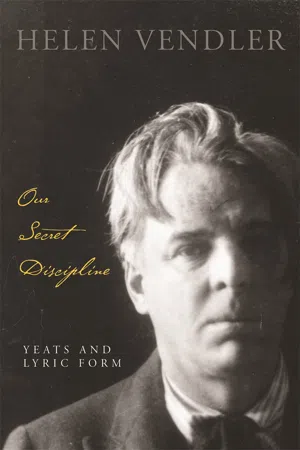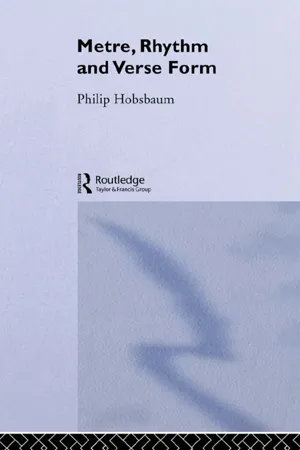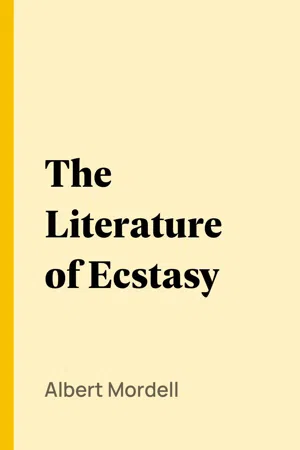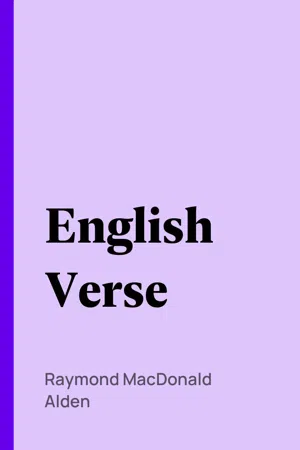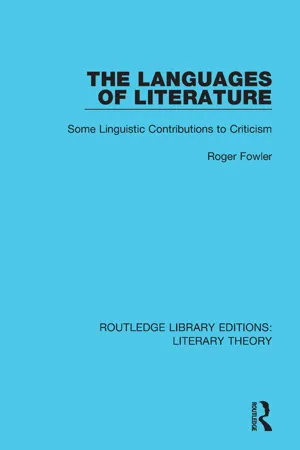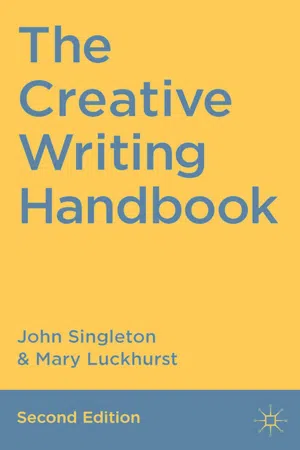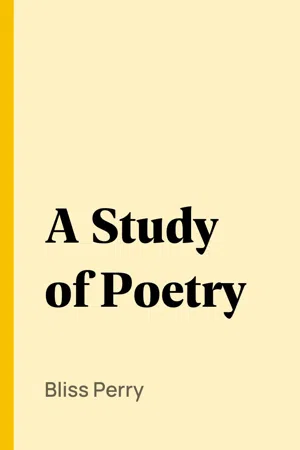Literature
Blank Verse
Blank verse is a form of poetry that consists of unrhymed lines in iambic pentameter. It is a flexible and natural-sounding verse form that has been widely used in English literature, particularly in dramatic works such as Shakespeare's plays. The lack of rhyme allows for greater freedom in expression and lends itself well to the portrayal of natural speech rhythms.
Written by Perlego with AI-assistance
Related key terms
1 of 5
10 Key excerpts on "Blank Verse"
- eBook - PDF
- Nigel McLoughlin(Author)
- 2017(Publication Date)
- Red Globe Press(Publisher)
Paul Ferris (London: Paladin) 59 8 Blank Verse Ros Barber What is it? Blank Verse, sometimes confused with free verse, is a metrical form, being unrhymed iambic pentameter. It is flexible enough to lend itself to a number of uses, but has most commonly been employed in long narrative and epic poetry (when it is sometimes known as heroic verse), dramatic monologue and drama. At the time Hamlet was written, Blank Verse was only around 60 years old. It can be dated to circa 1540, when it was first developed by Henry Howard, Earl of Surrey, who also – with Thomas Wyatt – was responsible for adapting an Italian form into the English (often called Shakespearean) sonnet. Howard, who was executed at the age of 30, translated two books of Virgil’s Aeneid into unrhymed iambic pentameter, creating a form that has proved itself the only English corollary of Latin heroic verse. The first Blank Verse play, Gorboduc , was written in 1561 by Thomas Sackville and Thomas Norton. It is monotonously end-stopped. It was Christopher Marlowe who wrote the first consistently successful Blank Verse dramas in the late 1580s and early 1590s, and his techniques were developed further by Shakespeare, who used increasingly more enjamb-ment and feminine line endings, as well as variation within the line, to break up the meter’s regularity. Milton’s Paradise Lost is written in Blank Verse; later exponents include Wordsworth, Shelley, Browning, Tennyson, Frost, Yeats and Wallace Stevens. Modern Blank Verse poets include Howard Nemerov, Richard Wilbur and Anthony Hecht. A comprehensive and very readable guide for further study is Blank Verse: A Guide to Its History and Use (2007) by Robert Burns Shaw. How does it work? Blank Verse consists of five metrical ‘feet’. A foot is a pattern of syllables, which may be stressed or unstressed. The six most common metrical feet are as follows: • iamb: weak-STRONG - eBook - PDF
The Shakespeare Workbook and Video
A Practical Course for Actors
- David Carey, Rebecca Clark Carey(Authors)
- 2015(Publication Date)
- Methuen Drama(Publisher)
But what are the characteristics of Blank Verse that Shakespeare inherited? Blank Verse was composed of unrhymed lines in the meter known as iambic pentameter . This term, which has come down to us from the poetry of classical Greece, tells us that the metrical structure of each line is based on a rhythmic unit (or foot ) composed of a syllable of weak stress followed by a syllable of stronger stress; for example, the word ‘composed’ would make such a rhythmic unit because the first syllable (com) is relatively weak or unstressed, while the second syllable (posed) is more strongly stressed This type of foot is called an iamb (from the use of this rhythm in Greek satirical poems called iambi ) and it occurs five times ( penta , from the Greek for ‘five’) in a line of iambic pentameter. RHYTHM AND METER 113 Take a look at this line from Marlowe’s Tamburlaine the Great, Part Two (Act 3 Scene 2): I’ll have you learn to sleep upon the ground Speak it out loud and notice how the writer has arranged it into a pattern of five iambic feet (the vertical line is used to show the foot divisions): I’ll have| you learn| to sleep| u-pon| the ground We call this a regular iambic pentameter line, because the pattern of a relatively weak syllable followed by a more strongly stressed syllable is kept constant over the five feet. But notice that not all the stressed syllables have the same weight: if you say the line quite naturally, it’s likely that learn , sleep and ground have more stress than have and -pon . Similarly, the unstressed syllables are not all equally weak: it’s likely that I’ll and you are more strongly stressed than to , u-, and the . This is because words with more semantic content (or significance) normally take more stress in English than words with little or no semantic content. So, the iambic pattern exists in the relative strength of the syllables in each foot rather than across the whole line. - eBook - PDF
Our Secret Discipline
Yeats and Lyric Form
- Helen Vendler(Author)
- 2007(Publication Date)
- Belknap Press(Publisher)
IX i The Medium of Instruction: Doctrine in Blank Verse When we think of Yeats’s poetry, it is, understandably enough, rhymed poems that come to mind. Yeats used most of the conventional forms of English rhyme, and brilliantly revived such stanzas as the trimeter abab qua-train and ottava rima. But Yeats also wrote unrhymed poems, most of them in Blank Verse, 1 unrhymed iambic pentameter. What fundamental differ-ence existed for him between rhymed verse and Blank Verse that led him to cast some materials into that unrhymed form? It is odd that there is rela-tively little Blank Verse in Yeats’s lyric poetry (by contrast to his narrative and dramatic poetry), 2 considering the prestige that lyric Blank Verse had ac-quired from its use in Wordsworth (rumination), Coleridge (“conversation poems”), and so on, down to Tennyson’s and Browning’s dramatic mono-logues. Blank Verse is one of the supreme English forms in drama and nar-rative (by Shakespeare and Milton); and perhaps that very fact kept Yeats the Irish nationalist from resorting to unrhymed pentameter with any fre-quency in his youth. 3 He avoided it then as he avoided the Shakespearean sonnet. What sort of poetic content required, in Yeats’s mind, “lyric” Blank Verse? The short answer to the question is that Yeats thought Blank Verse a good medium for two sorts of expository lyric occasions: dialogue on the one hand, and doctrine on the other. In the long run, doctrine supplanted dialogue. Dialogue is a genre that exists halfway between the solo voice of lyric and the choral (or social) voice of drama. The content of lyric dialogue, if it is to embody the poet’s quarrel with himself, must be confrontational, and Yeats would ultimately realize that fact. - eBook - ePub
- Philip Hobsbaum(Author)
- 2006(Publication Date)
- Routledge(Publisher)
Blank Verse, as has already been indicated, emerged in the mid-sixteenth century as an invention by the Earl of Surrey. Subsequently, it was used mostly for drama.The first play to be written in Blank Verse was Gorboduc by Thomas Sackville (1536–1608) and Thomas Norton (1532–84). It exhibits traits similar to those of Surrey’s translation of the Aeneidy in that its verse resolutely conforms to metre and admits little variety of rhythm. In a feeble anticipation of King Lear , an aged king is advised about his sons:If flattery then, which fails not to assail The tender minds of yet unskilful youth, In one shall kindle and increase disdain, And envy in the other’s heart inflame, This fire shall waste their love, their lives, their land, And ruthful ruin shall destroy them both.But, as the drama developed, Blank Verse became more varied and therefore more capable of poetry. The first practitioner of dramatic Blank Verse whose work can be performed effectively today was Christopher Marlowe (1564–93). His Tamburlaine the Great stems metrically formal, compared with later developments, but it still manages to incorporate a characteristic lyrical swing. Speaking of poets and their limitations, Tamburlaine says:If these had made one poem’s period, And all combined in beauty’s worthiness, Yet should there hover in their restless heads One thought, one grace, one wonder, at the least, Which into words no virtue can digest.There is a degree of emphasis here new to English poetry in that metrical form. The novelty may be located in the variety of stress; for example:Here is an inverted first foot, together with some lightly stressed syllables in the middle—more lightly stressed than would be the norm with a strictly metrical line of Blank Verse. In that inheres the lyrical swing.Shakespeare was slow to learn from this more precocious contemporary. His earlier verse, in Richard III - eBook - ePub
- Albert Mordell(Author)
- 2011(Publication Date)
- Perlego(Publisher)
Sagas, which Morris calls "unversified poetry." Some of these existed as early as the first part of the tenth century. It seems anomalous to the literary historian that a nation should at the very beginning of its literary history have developed prose before verse, that it should have celebrated its heroes in prose instead of verse song. All stories among ancient people were, however, originally told in prose; the first expression was always in rhythmical poetical prose.It is not true, then, that verse is the first form in which a nation's poetry is written, or that prose developed from verse. Prose was the original language of poetry, and to prose it should return. The pattern was a gradual development.FOOTNOTES:
[100-A] "The Religious Poetry of Babylonia." Presbyterian Review, 1888, p. 76.[105-A] There is an English translation of this work.CHAPTER VI
Blank Verse AND FREE VERSE AS FORMS OF PROSE
The unrhymed iambic pentameter known as Blank Verse is really a form of free verse; it is a modified form of the unrhymed classical measure. It made its appearance in Italy in the early part of the sixteenth century, and was used by Ariosto in his comedies, except that he employed a final additional unaccented syllable, making eleven syllables in each line. Surrey, who used it in his translation of two books of the Æneid, imported it from the Italians. It was called by the Italians versi sciolti, "untied or free verse." It was, then, the old classical measure with more freedom.In his essay, Blank Verse, John Addington Symonds dwells especially on the plasticity and variety of Blank Verse, which he says it has more than any other national metre. It may be used for the commonplace and the sublime, the tragic and the comic, etc. It does not have to consist of five iambuses only, but other feet may be substituted almost at the caprice of the poet. This, however, practically amounts to saying that Blank Verse is after all a great deal like prose; indeed, it may be arranged like modern free verse with great ease. Its plasticity and variety are due to the fact that its artificial requirements are less than those of most other metres. It was a fortunate day for English drama and poetry when Marlowe, Shakespeare and Milton, following in the footsteps of Surrey's translation of two books of the Æneid, and Sackville's and Norton's play, Gorboduc - eBook - ePub
English Verse
Specimens Illustrating its Principles and History
- Raymond MacDonald Alden(Author)
- 2010(Publication Date)
- Perlego(Publisher)
Paradise Lost, Book I. ll. 544-559; 571-587. 1667.)With head a while inclined, And eyes fast fixed, he stood, as one who prayed, Or some great matter in his mind revolved: At last, with head erect, thus cried aloud:— "Hitherto, Lords, what your commands imposed I have performed, as reason was, obeying, Not without wonder or delight beheld; Now, of my own accord, such other trial I mean to show you of my strength, yet greater, As with amaze shall strike all who behold." This uttered, straining all his nerves he bowed; As with the force of winds and waters pent When mountains tremble, those two massy pillars, With horrible convulsion to and fro He tugged, he shook, till down they came, and drew The whole roof after them with burst of thunder Upon the heads of all who sat beneath.(Milton : Samson Agonistes, ll. 1636-1652. 1671.)The Blank Verse of Milton is characterized by greater freedom and flexibility than that of any earlier poet. The single line practically ceases to be the unit of the verse, which is divided rather into metrical paragraphs, or, as some would even call them, stanzas. Professor Corson quotes an interesting passage from a letter of Coleridge, giving an account of a conversation in which Wordsworth expressed his view of this sort of Blank Verse. "My friend gave his definition and notion of harmonious verse, that it consisted (the English iambic Blank Verse above all) in the apt arrangement of pauses and cadences, and the sweep of whole paragraphs,with many a winding bout Of linked sweetness long drawn out,and not in the even flow, much less in the prominence or antithetic vigor of single lines, which were indeed injurious to the total effect, except where they were introduced for some specific purpose." (Corson's Primer of English Verse, p. 218.) In like manner Mr. Symonds says: "The most sonorous passages begin and end with interrupted lines, including in one organic structure, periods, parentheses, and paragraphs of fluent melody.... In these structures there are many pauses which enable the ear and voice to rest themselves, but none are perfect, none satisfy the want created by the opening hemistich, until the final and deliberate close is reached." (Blank Verse - eBook - ePub
The Languages of Literature
Some Linguistic Contributions to Criticism
- Roger Fowler(Author)
- 2016(Publication Date)
- Routledge(Publisher)
148–9; traditional elisions, as the unwatchful eye, l. 143. Such allusions, though discreetly and sparingly used, are potent signals to the experienced reader of Shakespeare and Milton, and they allow Wordsworth to relax the verse design to his own level of rhythmic fluidity. One tour de force of classical English Blank Verse is the accommodation of many-syllabled words. The iambic pentameter line has an internal structure based on two-stress units, but these units are reflected accurately in the stress patterns of only a small range of morphological and syntactic arrangements in English: two-syllabled words with the stress on the second syllable, such as above, beyond, away, pursue, and two-word phrases in which the first word is a lightly-stressed item such as a preposition, auxiliary verb, pronoun — he went, in debt, to go, my hat, etc. In the unlikely event that pentameter verse could be composed entirely of such units, the natural stress-pattern of the syntax would exactly realize the idealized stress-pattern of the verse design: alternating light and heavy stresses with only one contrast of level of stress: light versus heavy. In fact, the stress-patterns associated with English syntax and morphology are much more complicated and diverse, and the phonetic contours of English sentences require several rather subtle differentiations of stress-level. That is to say, stress-contrasts in English are more finely distinguished, and more various, than the simple two-level, up-and-down di-DAH-di-DAH pattern of the iambic verse design. Now polysyllabic words are a particular challenge because, to speak impressionistically, they level out the stress-contrasts and smooth the transitions between syllables. The impact of many polysyllabic words on the verse instance is to soften and relax it (and also speed it up) - eBook - PDF
- John Singleton, Mary Luckhurst, John Singleton, Mary Luckhurst(Authors)
- 2000(Publication Date)
- Bloomsbury Academic(Publisher)
It is broadly true, for instance, as my example of revi-sion suggests, that (in English) metres in which pairs of unstressed beats are repeated read rapidly, and lend them-selves to the comic -as happens in limericks, ti-ti-TUM-ti-ti-TUM-ti-ti-TUM, where the ti-tis are to the line as a skip is to walking. Conversely, the metre of most of Shakespeare's great speeches is ti-TUM-ti-TUM-ti-TUM-ti-TUM-ti-TUM (called 'Blank Verse', or 'iambic pentameter'), where the alternating stressed and unstressed beats prevent the line from skipping, inhibit unintended comedy, and help to sustain serious atten-tion to the content of the speech. Of course, many individual lines vary the strict pattern of 'iambic pentameter', a line of five iambs (5 x ti-TUM), but some conform exactly, and in every line the pattern is there as a model to vary from. As in twelve-bar blues the variation and distortion may be great but the simple and immensely strong basic structure can be heard through everything. As has happened to blues, though, the intrinsic qualities of a particular metre (or form) can become, over time, an extended baggage which the metre (or form) drags with it. Is it really impossible to write non-comically in a metre that skips? can you write a cheerful blues? These are serious questions, and the other vital aspect of learning about poetic craft is to iden-tify, and learn to use, the baggages that particular metres, forms, or other craft-elements drag with them. If the Chancel-lor of the Exchequer gave the Budget speech in limericks, you would be surprised; but a limerick is probably the only kind of poem you would not be surprised to find in a pub toilet, for as a form it has particular associations. Equally, sonnets have a WRITING VERSE 169 long history of use as poems of courtship, in which male wooers freeze and burn in love, but are disdained by chaste and icy women; so when W. - eBook - ePub
- Bliss Perry(Author)
- 2005(Publication Date)
- Perlego(Publisher)
Milton, in his zeal for Blank Verse, attacked rhyme, in which he had already proved himself a master, quite as fiercely as any of our contemporary champions of free verse. Campion, a trained musician, argued for a quantitative system of English prosody during the very period when he was composing, in the accentual system, some of the most exquisite songs in the language. Daniel, whose Defense of Rhyme (1603) was a triumphant reply to Campion's theory, gave courteous praise to his opponent's practice. Dryden, most flexible-minded of critics, argues now for, and now against the use of rhymed heroic couplets in the drama, fitting his theories to the changing currents of contemporary taste as well as to the varying, self-determined technique of his own plays. "Never wholly out of the way, nor in it," was Dryden's happy phrase to describe the artist's freedom, a freedom always conscious of underlying law. 2. Rhyme as a Form of Rhythm However theory and practice may happen to coincide or to drift apart, the fundamental law which justifies rhyme and stanza seems to be this: if rhythm is a primary fact in poetry, and metre is, as Aristotle called it, sections of rhythm, any device of repeating identical or nearly identical sounds at measured intervals is an aid to rhythmical effect. Rhyme is thus a form, an "externalizing" of rhythm. It is structural as well as decorative, or rather, it is one way of securing structure, of building verse. There are other devices, of course, for attaining symmetrical patterns, for conveying an impression of unity in variety - eBook - PDF
Best Words, Best Order
Essays on Poetry
- S. Dobyns(Author)
- 2016(Publication Date)
- Palgrave Macmillan(Publisher)
It is not simply a matter of breaking the iamb. For many poets the iamb doesn't feel appropriate. If the writer begins with the premise that the true poet's rhythms are personal, I I 6 I Best Words, Best Order and his or her own speech patterns form themselves, for instance, among descending rhythms, then, like Hass, he or she might develop a descending line that reflects those rhythms. Clearly there are many poets who write comfortably in a loose iambic line-poets such as Heather McHugh and Ellen Bryant Voigt and many others-but the rejection of metered verse by so many American poets cannot be attributed to perversity or ignorance. It has to be seen as a reflection of their belief that the strict iambic pentameter line feels uncomfortable to their voice. William Carlos Williams wrote, "We have had a choice: either to stay within the rules of English prosody, an area formed and limited by the English character and marked by tremendous masterwork, or to break out, as Whitman did, more or less unequipped to do more. Either to return to rules, more or less arbitrary in their delimitations, or to go ahead; to invent other forms by using a new measure." 171 Elsewhere he wrote, "A language . . . which will not conform to rigid prosodic rules is forced to break those rules if it is to be retained in its own character .... It is the refusal of English (especially American English) to conform to standard prosody which has given rise to free verse." 172 Williams's solution was to discover a poetic rhythm that matched his own voice. The unit of measurement that he devel- oped for this rhythm he called the variable foot. He wrote: The crux of the question is measure. In free verse the measure has been loosened to give more play to vocabulary and syntax-hence, to the mind in its excursions. The bracket of the customary foot has been expanded so that more syllables, words, or phrases can be admitted into its confines.
Index pages curate the most relevant extracts from our library of academic textbooks. They’ve been created using an in-house natural language model (NLM), each adding context and meaning to key research topics.


